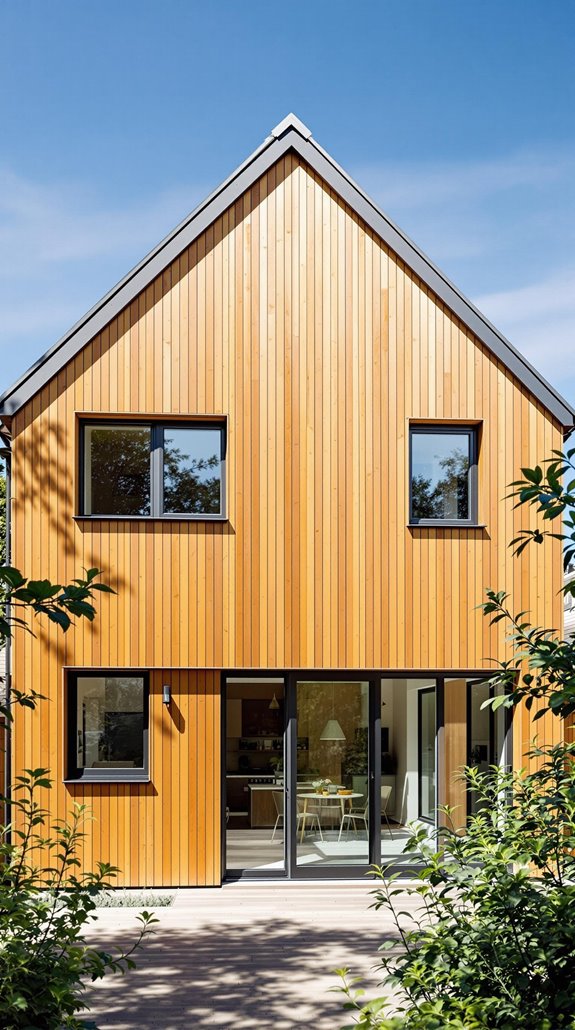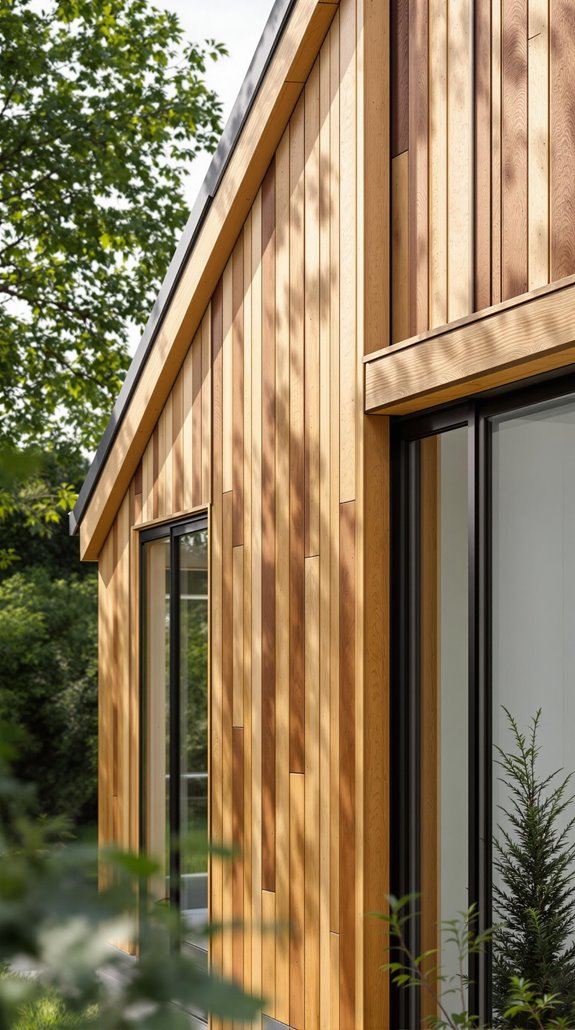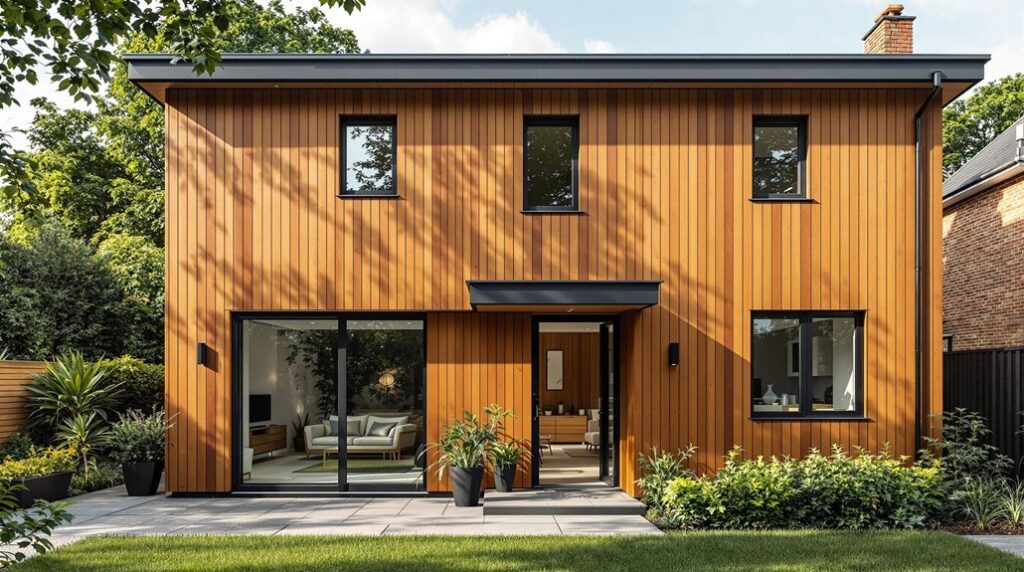I’ve worked with countless UK homeowners who’ve transformed their timber frame houses through strategic cladding choices, and I can tell you that the right material selection makes all the difference between a mediocre exterior and one that genuinely enhances your property’s value. While Western Red Cedar and Siberian Larch remain popular choices, there’s a growing trend toward hybrid approaches that combine traditional timber with modern alternatives—creating distinctive facades that address both aesthetic ambitions and the practical demands of Britain’s challenging climate conditions.
Key Takeaways
- Western Red Cedar and Siberian Larch offer exceptional stability with distinctive grain patterns for striking UK home exteriors.
- Composite and fiber-cement cladding provide wood-like aesthetics with minimal maintenance requirements and superior weather resistance.
- Modern metal options like zinc and aluminium deliver sleek finishes with natural corrosion resistance, perfect for coastal properties.
- Vertical panel installations with matte finishes enhance visual appeal while maintaining proper ventilation cavity requirements.
- Professional installation with stainless steel fixings ensures long-term performance exceeding 30 years with proper maintenance schedules.
Popular Cladding Materials for UK Timber Frame Homes

When selecting cladding materials for your timber frame home, you’ll find several proven options that combine durability with aesthetic appeal. Western Red Cedar stands out as my top recommendation, offering exceptional stability and natural decay resistance with its distinctive reddish-brown grain. Siberian Larch provides excellent dimensional stability and comes in both knot-free ‘unsorted’ and character-rich ‘sawfalling’ grades. Douglas Fir delivers scratch-resistant strength with striking dark growth rings, while European Larch meets British Standards Class 3 durability without preservative treatment. For premium applications, I’d suggest Oak or Sequoia hardwoods, which offer Class 1-2 durability ratings. Each species weathers naturally to an attractive silvery-grey patina, requiring minimal maintenance while providing decades of reliable performance for your home’s exterior. Thermally-treated softwoods like Thermo-pine and Thermo-ayous are also gaining popularity as cost-effective alternatives to traditional hardwoods. Additionally, using insulation materials not only enhances the comfort of your home but also contributes to improved energy efficiency.
Modern Metal Cladding Options for Contemporary Appeal
While timber cladding offers timeless appeal, modern metal options deliver the clean lines and industrial aesthetics that define contemporary architecture. I’ve seen zinc cladding transform ordinary homes with its sleek finish and natural corrosion resistance, while galvanised steel provides unmatched durability for harsh UK weather. Aluminium works brilliantly in coastal areas, offering rust-proof performance with lightweight flexibility. Additionally, incorporating sustainable materials into your design can enhance both aesthetics and environmental impact.
What I particularly appreciate about metal cladding is its design versatility. You can create dramatic contrasts with matte black finishes or use vertical panels to enhance your home’s scale. The performance benefits are equally impressive – minimal maintenance, exceptional weather resistance, and thermal efficiency that reduces cooling costs. With prefabricated panels cutting build times by 30-50%, metal cladding integrates seamlessly with timber frame systems while meeting stringent UK building regulations.
Metal cladding stands out as a non-combustible option, providing enhanced safety benefits alongside its aesthetic and performance advantages.
Natural Timber Species and Their Aesthetic Benefits
Metal cladding offers contemporary appeal, but natural timber species deliver the warmth and character that many homeowners seek for their timber frame projects.
European Oak provides rich golden-brown tones with distinctive grain patterns that create visual depth. Its natural durability guarantees long-lasting beauty while developing an attractive silver-grey patina over time.
Siberian Larch offers pale yellow to medium brownish colours with distinctively strong grain patterns. The medium-to-fine texture adds character through visible growth rings.
Douglas Fir delivers warm reddish-brown heartwood with contrasting pale sapwood, creating natural colour variation that enhances visual interest. This softwood offers an excellent strength-to-weight ratio that ensures structural stability for cladding applications.
Western Red Cedar features rich reddish-brown hues with straight grain patterns that weather to elegant silver-grey tones.
Thermo-Treated Meranti combines tropical hardwood beauty with enhanced stability and uniform colouring for consistent aesthetic appeal.
Composite and Fiber-Cement Solutions for Low Maintenance
Although natural timber species offer undeniable warmth and character, composite and fiber-cement cladding solutions provide compelling alternatives for homeowners who prioritize long-term durability with minimal upkeep demands. Notably, these materials can also help boost your home’s value significantly by enhancing its overall aesthetic appeal.
I’ve found composite cladding particularly appealing because it mimics wood grain textures without requiring painting, sealing, or chemical treatments. You’ll only need soapy water and a brush for cleaning—no specialized products necessary. Fiber-cement options excel in extreme conditions, withstanding heavy rain, UV exposure, and sub-zero temperatures without warping.
Both materials resist moisture absorption, preventing the swelling and rot that plague timber installations. For coastal properties, fiber-cement’s superior saltwater resistance proves invaluable. The thermal insulation properties of composite cladding reduce energy costs, while both options maintain structural integrity under high winds and debris impact. Additionally, fiber-cement cladding offers complete pest resistance due to its zero organic material composition, making it an excellent choice for areas prone to termite infestations.
Essential Installation Requirements and Professional Fitting

Before you begin any timber cladding project, understanding the critical installation requirements will determine whether your investment delivers lasting performance or costly maintenance headaches.
You’ll need a minimum 50mm ventilated cavity between your cladding and timber frame structure. This isn’t negotiable – it’s vital for moisture control and structural integrity. The brickwork splash course must be installed before your timber frame sole plate to maintain this cavity properly. Conducting a drainage survey can help identify potential moisture issues in the surrounding area that could affect your cladding’s durability.
I recommend professional installation using grade 304 stainless steel fixings exclusively. These prevent corrosion and guarantee longevity. Your battens need minimum 38mm thickness with pressure treatment, fixed at maximum 1500mm centres for adequate ventilation.
Always ensure your timber is fully acclimatized before installation to prevent dimensional changes that could compromise your cladding’s appearance and performance over time.
Cost Analysis and Budget Planning for Cladding Projects
Understanding installation requirements sets the foundation, but your project’s success ultimately depends on accurate cost planning and realistic budget allocation. I’ll break down the key cost factors you need to evaluate.
Material choice drives the biggest price variations. uPVC cladding averages £80/m² including labour, while timber larch ranges £100-£130/m² and cedar costs £150-£180/m². Premium options like aluminium hit £215/m² and zinc reaches £300-£350/m². Additionally, regional price variations can significantly affect your budget, so it’s essential to research local costs before committing.
Don’t overlook ancillary expenses. Scaffolding adds £15-25/m² to your project, skip hire averages £400, and corner profiles cost £3.60-£8.90/m depending on timber species. Timber treatment greatly impacts pricing – air-dried materials cost 45-105% more than wet alternatives.
Budget for material selection causing 71% cost variance between options. Property size and shape significantly influence total costs, with small single-storey bungalows averaging approximately £5,000 while two-storey homes reach around £8,000.
Maintenance Schedules and Long-Term Performance Expectations
While proper budgeting gets your timber frame cladding project off the ground, consistent maintenance determines whether you’ll achieve the expected 30+ year lifespan or face premature replacement costs.
I recommend establishing a biannual inspection routine—spring for post-winter assessment and autumn for pre-winter preparation. You’ll need annual deep cleaning with brightening agents, followed by gentle wiping with soapy water. Avoid pressure washing, which damages timber surfaces. Additionally, sealing gaps and cracks can help prevent moisture penetration and prolong the life of your cladding.
Treatment reapplication cycles vary dramatically: high-exposure areas need retreatment every 2 years, while protected sections can extend to 5 years. Urban environments accelerate soiling, requiring more frequent cleaning to prevent darkening. When cracks appear, immediately apply filling products to maintain the cladding’s structural integrity and prevent moisture penetration.
Professional assessments every 5-10 years evaluate structural integrity and coating adhesion. Document treatment dates and exposure levels—this data helps predict your next maintenance window and prevents costly deterioration.
Conclusion
I’ve covered the key cladding options for your UK timber frame home, from natural cedar to modern composites. You’ll need to balance aesthetics, budget, and maintenance requirements when choosing materials. Don’t skip professional installation – it’s essential for weatherproofing and longevity. Factor in ongoing maintenance costs alongside initial investment. With proper planning and quality materials, your cladding project will enhance your home’s appearance and performance for decades. Choose wisely and invest in professional fitting.
References
- https://www.self-build.co.uk/timber-frame-cladding-options/
- https://turnertimber.co.uk/cladding.pdf
- https://extensionarchitecture.co.uk/blog/a-comprehensive-guide-to-timber-frame-constructions/
- https://www.self-build.co.uk/timber-cladding-options-explained/
- https://www.cladcodecking.co.uk/blog/post/types-of-house-cladding
- https://duffieldtimber.com/the-workbench/cladding/timber-cladding-guide-best-species-profiles-options
- https://www.firstinarchitecture.co.uk/detail-post-timber-cladding-details/
- https://www.vulcansystems.co.uk/blog/20-best-external-cladding-options-2024/
- https://www.self-build.co.uk/best-timber-frame-projects/
- https://www.structuraltimber.co.uk/wp-content/uploads/2022/09/STA-Living-in-a-Timber-Frame-Home.pdf

